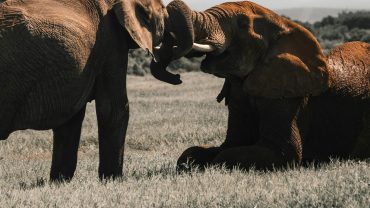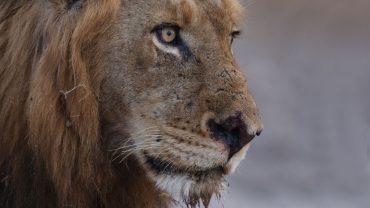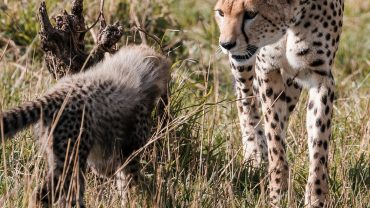places to see Rhinos in Kenya : Kenya is known for its incredible wildlife, including the magnificent rhinoceros. To see rhinos in Kenya, you can visit various national parks and reserves that are dedicated to wildlife conservation. Here are some of the popular destinations where you have a good chance of spotting rhinos:
1.Maasai Mara National Reserve
Located in south-western Kenya, Maasai Mara is famous for its annual wildebeest migration. While rhinos are not as common here as other species, you may still have a chance to see them. While rhinos are not commonly found in Maasai Mara National Reserve, there have been occasional sightings of both black and white rhinos in the area. The reserve is not considered a prime rhino habitat, but due to its proximity to other conservancies and parks where rhinos are present, there have been occasional reports of rhino sightings within Maasai Mara.
It’s important to note that rhinos in Maasai Mara are not a guaranteed sighting, and the chances of seeing them there are relatively low compared to other parks and conservancies specifically dedicated to rhino conservation. If your main objective is to see rhinos, it would be advisable to visit the locations such as Ol Pejeta Conservancy, Lake Nakuru National Park, Amboseli National Park, or Tsavo East and Tsavo West National Parks. These areas have more reliable populations of rhinos and offer better opportunities for sightings.
2.Amboseli National Park
Situated in southern Kenya near the Tanzanian border, Amboseli National Park offers fantastic views of Mount Kilimanjaro as a backdrop. It’s home to both black and white rhinos, and you may spot them while exploring the park.
Amboseli National Park does not have a resident population of rhinos. Historically, the park was home to both black and white rhinos, but due to poaching and habitat changes, the rhino populations in Amboseli have significantly declined. The park authorities have made efforts to reintroduce rhinos in recent years, but the success of these initiatives and the presence of rhinos in Amboseli can vary over time.
For a higher chance of encountering rhinos in Kenya, I recommend visiting Ol Pejeta Conservancy, which is renowned for its successful rhino conservation efforts and is located in Laikipia County. Ol Pejeta has both black and white rhinos and offers guided tours and experiences focused on rhino conservation.
Please note that the conservation status and presence of wildlife populations can change over time, so it’s always advisable to check with the latest information from reliable sources or contact local authorities or tour operators when planning a visit to any specific location in Kenya.
- 5 places to see Rhinos in Kenya : Ol Pejeta Conservancy
This private conservancy, located in Laikipia County, is one of the best places in Kenya to see rhinos. Ol Pejeta has a dedicated rhino sanctuary and is home to both black and white rhinos. It offers various activities such as game drives, guided walks, and even the opportunity to participate in rhino conservation efforts.
Ol Pejeta Conservancy is known for its successful rhino conservation efforts and is one of the best places in Kenya to see rhinos. It is located in Laikipia County and is home to both black and white rhinos. The conservancy has a dedicated rhino sanctuary that plays a crucial role in protecting and conserving these endangered species.
Ol Pejeta Conservancy
Ol Pejeta is the largest black rhino sanctuary in East Africa, and it also has a significant population of white rhinos. The conservancy offers various activities for visitors, including game drives and guided walks, which provide opportunities to spot rhinos in their natural habitat.
In addition to regular game drives, Ol Pejeta offers unique experiences such as rhino tracking, where you can join rangers in monitoring and observing rhinos up close. These activities provide educational insights into rhino conservation and the challenges faced in protecting these magnificent animals.
It’s important to note that Ol Pejeta Conservancy is a private wildlife conservancy that prioritizes wildlife conservation and community development. By visiting Ol Pejeta, you not only have the opportunity to see rhinos but also contribute to their conservation efforts.
- 5 places to see Rhinos in Kenya : Lake Nakuru National Park
Situated in the Great Rift Valley, Lake Nakuru National Park is known for its vast populations of flamingos. It is also home to both black and white rhinos, making it another good option for rhino sightings.
Lake Nakuru National Park is another popular destination in Kenya where you can find rhinos. The park is located in the Great Rift Valley and is renowned for its large population of both black and white rhinos.
Lake Nakuru National Park has a dedicated rhino sanctuary within its boundaries, which provides a protected habitat for these endangered animals. The sanctuary has been successful in conserving and increasing the rhino populations over the years.
While exploring the park, you have a good chance of spotting rhinos during game drives and while visiting viewpoints and observation areas. The park is also home to other diverse wildlife, including flamingos, zebras, giraffes, buffalos, and various bird species.
To maximize your chances of seeing rhinos in Lake Nakuru National Park, it is recommended to hire an experienced guide or join organized tours that have knowledge of the park and its wildlife. They can help you navigate the park and provide insights into the behavior and conservation efforts of rhinos.
Please note that wildlife sightings can vary, and it’s important to maintain respect for the animals and follow park regulations and guidelines to ensure their protection and your own safety while visiting Lake Nakuru National Park.
- 5 places to see Rhinos in Kenya : Tsavo East and Tsavo West National Parks
These neighbouring national parks, located in south-eastern Kenya, form one of the largest protected areas in the country. They are home to both black and white rhinos, and you can explore the diverse landscapes while searching for these majestic creatures.
Both Tsavo East and Tsavo West National Parks in Kenya are home to rhinoceros populations, offering opportunities to see these magnificent creatures in their natural habitat.
Tsavo East National Park, one of the oldest and largest national parks in Kenya, is home to both black and white rhinos. The park’s vast savannahs, scrublands, and acacia woodlands provide suitable habitats for these endangered species. Exploring the park on game drives or guided walks increases your chances of spotting rhinos, among other wildlife like elephants, lions, zebras, and giraffes.
Tsavo West National Park is adjacent to Tsavo East and also supports populations of black and white rhinos. The park’s diverse landscapes, including grasslands, volcanic hills, and riverine forests, create a unique environment for wildlife. Embarking on game drives or guided walks in Tsavo West increases the possibility of rhino sightings, along with encounters with other iconic animals like leopards, buffalos, and hippos.
It’s important to note that rhinos are endangered species, and their populations are fragile. The rhino populations in Tsavo are carefully protected and monitored to ensure their conservation. When visiting these national parks, it’s crucial to adhere to park regulations, maintain a respectful distance from the wildlife, and follow the guidance of experienced guides or rangers to contribute to the protection of these incredible animals.
Please keep in mind that wildlife sightings can vary, and it’s advisable to check with the latest information from park authorities or local tour operators to enhance your chances of seeing rhinos during your visit to Tsavo East and Tsavo West National Parks.
When planning a trip to see rhinos in Kenya, it’s important to remember that rhinos are endangered species and their populations are fragile. Ensure you visit reputable and responsible wildlife conservation areas that prioritize the well-being and protection of these animals. It’s also advisable to hire experienced guides or join organized tours for the best chances of spotting rhinos and to learn more about their conservation efforts.



Comment (0)